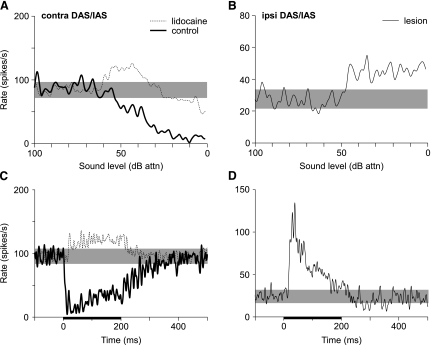Fig. 7.
Effects of blockade of the contralateral (left) and ipsilateral (right) acoustic striae on the responses of DCN type IV units to contralateral broadband noise. A, C: Plots show discharge rate vs. noise level functions (A) and PSTHs (C) for a type IV unit (98/09/02, unit 5.01, BF = 24 kHz) before (heavy solid lines) and 5 min after (dotted lines) pressure injection of lidocaine into the contralateral dorsal (DAS) and intermediate acoustic striae (IAS). The shaded bars show the range of SR. Note that blockade of the contralateral DAS/IAS blocks, in part, the inhibitory responses of type IV units to contralateral noise, including the onset of inhibition, and reveals underlying excitation. B, D: Noise rate-level function (B) and PSTH (D) for a type IV unit (98/10/20, unit 6.02, BF = 33.5 kHz) after the ipsilateral DAS/IAS is surgically cut. Type IV units are strictly excited by contralateral stimulation after this manipulation.

